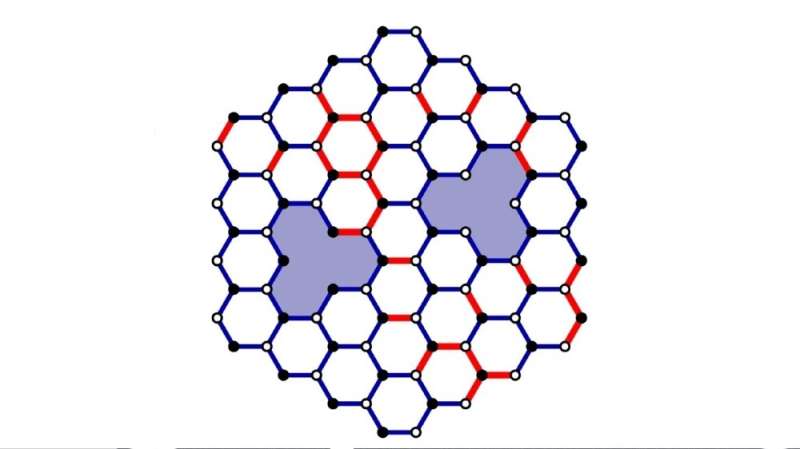Study makes spin liquid model more realistic

Spin is the intrinsic magnetic moment of a particle—an electron, for example. It is a fundamental magnitude, like mass and charge. Simply put, it is as if the particle had a magnet inside it that enabled it to interact, even while at rest, not only with the spins of other particles but also with external magnetic fields.
By analogy with usual liquids, a system in which spins do not exhibit magnetic order, even at temperatures close to absolute zero, is termed a spin liquid. In accordance with the same logic, a system with magnetic order is a spin solid, since the magnetic order of its spins is analogous to the periodic order of the atoms in a crystal.
Exploration of these systems helps scientists understand fundamental aspects of matter and could lead eventually to an important practical application—topological quantum computing. A considerable research effort is under way in the field for this very reason. An example is the article "Disorder, low-energy excitations, and topology in the Kitaev spin liquid" published in Physical Review Letters.
"The Kitaev model [formulated by Alexei Yurievich Kitaev, born in Russia in 1963, now a naturalized US citizen and a professor at the California Institute of Technology] is a two-dimensional spin liquid. It's very interesting but somewhat artificial. Deviations from the original model are expected to appear in real materials and that is what we investigated," Eric Andrade, last author of the article, told Agência FAPESP. Andrade is a professor at the University of São Paulo's São Carlos Institute of Physics (IFSC-USP) in Brazil.
Andrade and Vitor Dantas, whose Ph.D. research he supervises, studied how Kitaev's model behaves in a honeycomb lattice in the presence of defects and disturbances such as a magnetic field and additional interactions.
"Since 2009, there have been robust theoretical proposals that the model can be realized in Mott insulators, which exhibit strong spin-orbit coupling," Andrade said.
Mott insulators are complex materials that act as electrical insulators but have spin dynamics and behave like magnetic materials. Scientists are very interested in them because of the possibility of accessing electron charge and spin separately, which gives rise to a wealth of unique physical properties, such as those of spin liquids. "In this study, the electrons were frozen in space, as it were, so that their mass and charge didn't participate in the dynamics at low temperatures. The only contribution came from spin," Andrade said.
Spin-orbit coupling is a manifestation of restricted relativity in atomic and condensed matter systems. This effect couples the electron's spin with its movement in three-dimensional space. "This is essential to create magnetic Kitaev interactions. A prerequisite for the relevance of this term is that the system's magnetic atom has a very high atomic number. For this reason, Kitaev materials usually involve iridium [Ir] and ruthenium [Ru]," Andrade said.
The study reported by Andrade and Dantas focused on an iridium oxide, H3LiIr2O6. This Mott insulator shows no magnetic order down to 50 millikelvin, making it a prominent candidate to realize Kitaev's spin-liquid phase.
"We succeeded in explaining the contradictions between the predictions of the pure Kitaev model and the experimental results obtained with H3LiIr2O6. We showed that the presence of a small number of vacancies was sufficient to explain the experimental data. The vacancies correspond to replacement of the magnetic ion by a non-magnetic ion. Because hydrogen is a very light element, these defects are expected to appear in the system during the crystallization process," Andrade said.
"Our work provided a consistent framework for experiments involving disordered Kitaev spin liquids and also produced an important prediction: this material should exhibit a topological phase in the presence of an external magnetic field. In effect, the topological phase is characterized by the presence, at the edge of the system, of Majorana fermions that carry a quantized energy current. This result is impressive if we recall that we're talking about a Mott insulator for which the electron charges are frozen and which therefore cannot transport electrical current."
The existence of Majorana fermions has been intensely explored. In a paper dated 1937, Italian physicist Ettore Majorana, who is considered one of the greatest geniuses in the history of science and vanished without trace at the age of 31, presented the hypothesis that a particle could be its own antiparticle and suggested that the neutrino could be such a particle.
Current research focuses not just on the neutrino but also on quasi-particles, or apparent particles, which consist of excitations in condensed matter systems. Besides the interest they arouse in fundamental physics, these exotic particles, generically called Majorana fermions, define an important frontier in quantum information and quantum computing, where they could be used for error correction, for example. The study discussed here contributes to the understanding of these fermions.
More information: Vitor Dantas et al, Disorder, Low-Energy Excitations, and Topology in the Kitaev Spin Liquid, Physical Review Letters (2022). DOI: 10.1103/PhysRevLett.129.037204
Journal information: Physical Review Letters
Provided by FAPESP




















